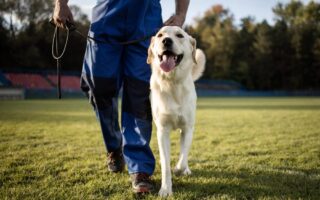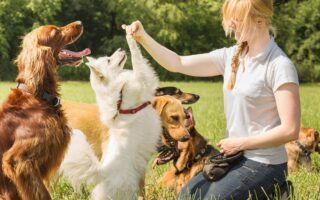Puppies are renowned for their boundless energy and playful antics, captivating our hearts with every wag of their tails. However, their playful nature can sometimes lead to a not-so-charming behavior: nipping. While it may seem harmless at first, those tiny teeth can quickly turn from cute to problematic if not addressed early. In this article, we’ll explore effective strategies to curb puppy nipping, ensuring that your furry friend learns the difference between playtime fun and behavior that could be troublesome down the line. With patience and understanding, you can transform that playful nip into a gentle play, creating a harmonious environment for both you and your pup. Join us as we delve into the reasons behind this behavior and discover practical tips to guide your puppy toward becoming the well-mannered companion you envision.
Table of Contents
- Understanding the Root Causes of Puppy Nipping
- Effective Training Techniques to Curb Nipping Behavior
- Redirecting Puppy Energy Towards Positive Outlets
- Establishing Consistent Boundaries and Reinforcement Strategies
- Q&A
- Wrapping Up
Understanding the Root Causes of Puppy Nipping
Puppy nipping is often a natural behavior, rooted in a variety of factors that may surprise new pet owners. One primary cause is the exploratory nature of puppies. Like human infants, they learn about their world through touch and bite. Their mouths are essential tools for exploration, and when they interact with their surroundings, nipping can be a way of engaging with and understanding their environment. Additionally, puppies are known to play wrestle with their littermates, during which they develop essential social skills. However, this playful behavior can easily transition to improper interactions with humans, resulting in nipping as part of their playfulness.
Another significant factor contributing to nipping is the teething process. Just like human babies, puppies experience discomfort as their teeth come in, and they seek relief by chewing on objects, including hands and fingers. This behavior signifies their need for comfort and distraction rather than aggression. Recognizing these underlying motivations can help owners adopt appropriate responses. To manage this behavior effectively, consider the following strategies:
- Provide appropriate chew toys to redirect nipping.
- Encourage socialization with other dogs to help them learn appropriate boundaries.
- Implement positive reinforcement techniques when they play gently.
Effective Training Techniques to Curb Nipping Behavior
Nipping is a natural behavior for puppies, but it can be managed through effective training techniques. One approach is to redirect their energy towards more appropriate activities. When you notice your puppy nipping, have a selection of chew toys or interactive games ready to divert their attention. Consistently encouraging your puppy to engage with these alternatives not only teaches them what is acceptable to bite but also helps them develop better chewing habits.
Another vital technique is to implement non-violent corrections. If your puppy nips at your fingers, let out a high-pitched yelp to mimic the sound a littermate might make, which signals them to stop. Following this, you should withdraw attention for a moment. This teaches the puppy that nipping leads to loss of playtime. Pair this technique with positive reinforcement, such as treats and praise when they play gently, to reinforce good behavior. A balanced combination of redirection and correction is essential for a well-behaved puppy.
Redirecting Puppy Energy Towards Positive Outlets
Redirecting your puppy’s boundless energy towards constructive activities is essential for promoting good behavior and ensuring a happy, healthy pet. Puppies are naturally curious and energetic, and when their enthusiasm isn’t channeled properly, they can become overly nippy and rambunctious. One effective way to harness this energy is through regular play sessions. Consider the following activities:
- Interactive Toys: Invest in toys that dispense treats to keep your puppy engaged.
- Training Sessions: Consistent training not only teaches commands but also directs their energy towards learning.
- Socialization Opportunities: Arrange playdates with other dogs to allow them to interact and expel energy.
Establishing a routine filled with physical and mental exercises can greatly diminish puppy nipping. Incorporate daily walks, tug-of-war games, and puzzle toys that require problem-solving skills. Below is a simple table highlighting some effective ways to redirect your puppy’s energy:
| Activity | Benefits |
|---|---|
| Fetch | Burns energy and encourages obedience. |
| Agility Training | Boosts confidence and physical coordination. |
| Hide and Seek | Enhances focus and mental agility. |
Establishing Consistent Boundaries and Reinforcement Strategies
Creating a nurturing environment for your puppy involves establishing clear and consistent boundaries. Puppies thrive on structure, and knowing the rules can help them feel secure. To manage nipping, implement the following strategies:
- Consistent Commands: Use short, clear commands like “no” or “gentle” every time your puppy nips. Consistency reinforces understanding.
- Redirecting Behavior: Whenever your puppy attempts to nip, provide an appropriate toy to redirect their energy. This helps build positive associations.
- Socialization Opportunities: Allow your puppy to interact with other dogs in controlled settings. This can teach bite inhibition through play.
Reinforcement strategies play an equally vital role in shaping your puppy’s behavior. Positive reinforcement encourages desired actions. Consider these methods:
- Praise and Treats: When your puppy interacts gently, reward them with verbal praise and treats to reinforce that behavior.
- Time-Outs: If nipping occurs, calmly remove your puppy from the situation for a brief time-out. This teaches them that nipping leads to loss of playtime.
- Consistent Playtime: Engage in structured play sessions that teach your puppy how to play gently, promoting a natural sense of boundaries.
Q&A
Q&A: How to Stop Puppy Nipping
Q1: What is puppy nipping, and why do puppies do it?
A1: Puppy nipping is a common behavior where young dogs use their mouths to playfully bite or nip at people and objects. Puppies explore the world with their mouths, much like infants do with their hands. This behavior often mimics the way they play with their littermates, learning vital social skills. However, while nipping is normal in puppyhood, it’s essential to guide them towards more appropriate behaviors as they grow.
Q2: At what age does puppy nipping typically start and stop?
A2: Nipping usually begins in the early weeks of life as puppies play and socialize with their siblings. It’s most prevalent between the ages of 3 to 6 months. As they grow and receive training, the nipping should gradually subside. However, without proper guidance, it can persist into adulthood, leading to behavioral issues.
Q3: What are some effective strategies to curb puppy nipping?
A3: Here are several techniques to help you manage and reduce nipping:
- Redirect the Behavior: Offer an appropriate chew toy when your puppy starts nipping. This teaches them what is acceptable to bite.
- Positive Reinforcement: Reward your puppy with praise or treats when they engage in non-nipping behavior. Reinforce calm interactions to foster more gentle play.
- Use a Time-Out: If your puppy nips too hard, let out a yelp or a firm “no,” then immediately withdraw your attention. A brief time-out can communicate that nipping results in loss of play.
- Socialization: Expose your puppy to other dogs and people in controlled settings to help teach bite inhibition through appropriate play.
Q4: Is it possible for nipping to become a behavioral issue later in life?
A4: Yes, if nipping is not addressed during puppyhood, it can persist into adulthood and lead to more serious behavioral problems such as aggression or anxiety. Establishing consistent boundaries early on is crucial to prevent these issues and ensure that your dog grows into a well-adjusted adult.
Q5: What should I do if my puppy continues to nip despite my efforts?
A5: If nipping persists, consider consulting with a professional dog trainer or a behaviorist who specializes in puppy training. They can provide personalized strategies and support tailored to your puppy’s specific needs.
Q6: Can certain breeds be more prone to nipping than others?
A6: While all puppies can nip, some breeds are known for higher energy levels or playful natures, which may lead to more frequent nipping behaviors. Breeds that were historically bred for herding or hunting may have a stronger tendency to bite during play. Understanding your puppy’s breed characteristics can help tailor your training approach.
Q7: When should I start training my puppy to stop nipping?
A7: Training should start as soon as you bring your puppy home. Early intervention is key; the younger the puppy, the more receptive they will be to learning. Establishing boundaries and teaching appropriate behavior from the outset helps set the foundation for a well-behaved adult dog.
Q8: Are there any tools or products that can help manage nipping?
A8: Yes, various tools can aid in managing nipping behaviors. Chew toys designed specifically for puppies can provide an outlet for their natural biting instinct. Additionally, puzzle toys can engage their minds to reduce boredom and excessive nipping. Always choose safe, durable products suitable for your puppy’s age and size.
By understanding the nuances of puppy nipping and employing effective training techniques, you can help your furry friend learn appropriate ways to interact with the world around them. Remember, patience and consistency are key!
Wrapping Up
As we conclude our exploration of the common yet often frustrating challenge of puppy nipping, it’s crucial to remember that patience and consistency are your best allies in this journey. Every puppy is a unique little individual, full of curiosity and energy, and understanding their world is key to guiding them toward appropriate behaviors. By employing the techniques we’ve discussed—from positive reinforcement to engaging playtime alternatives—you’re not just curbing unwanted nipping; you’re also building a strong foundation of trust and communication with your furry friend.
As you embark on this training adventure, remember that setbacks are part of the process and that every small victory counts. Celebrate the progress you make, no matter how incremental, and take solace in the knowledge that with time and effort, your puppy will grow into the well-mannered companion you envision. Here’s to many happy, nip-free moments ahead, as you nurture a loving bond that will last a lifetime. Happy training!



